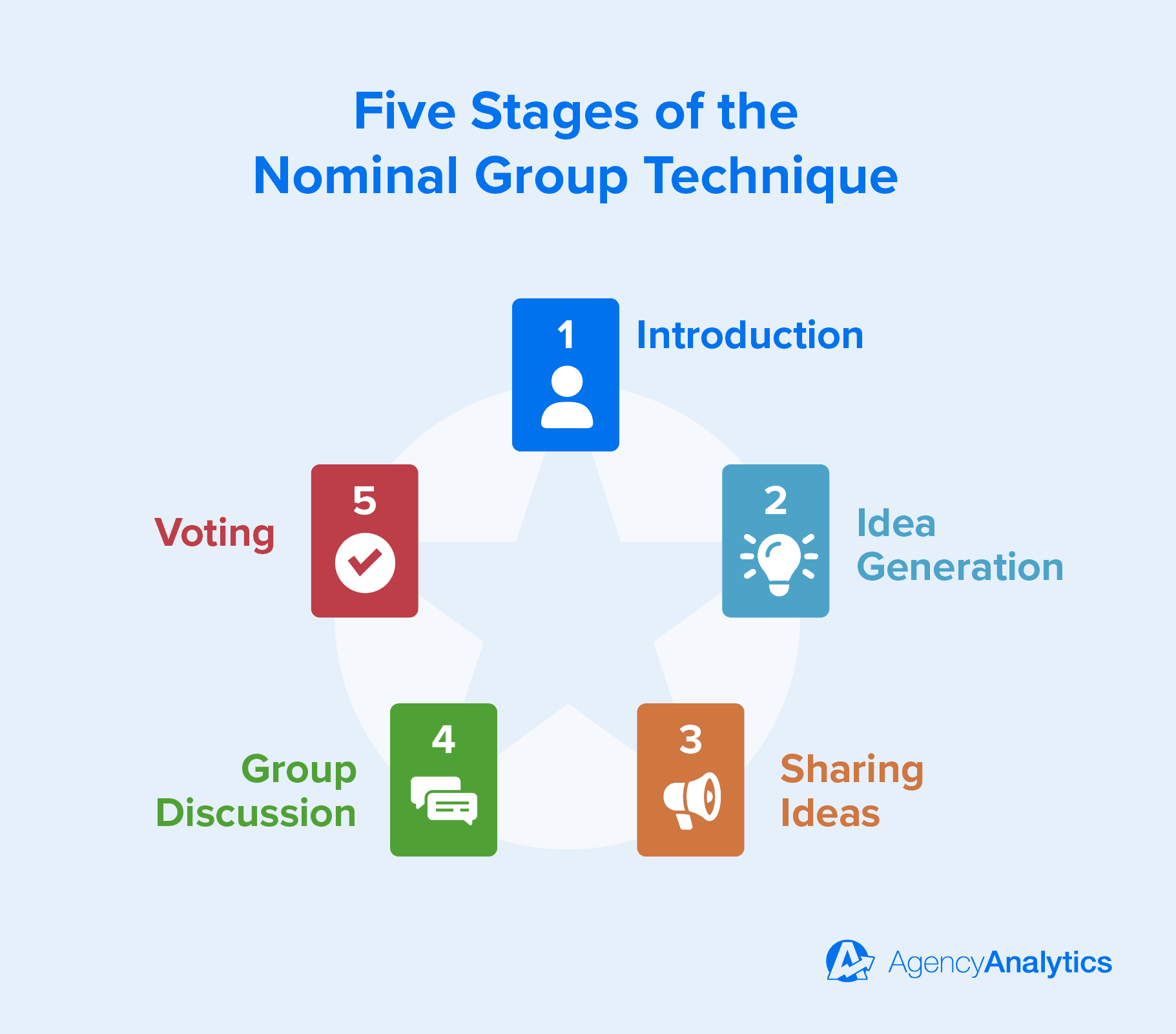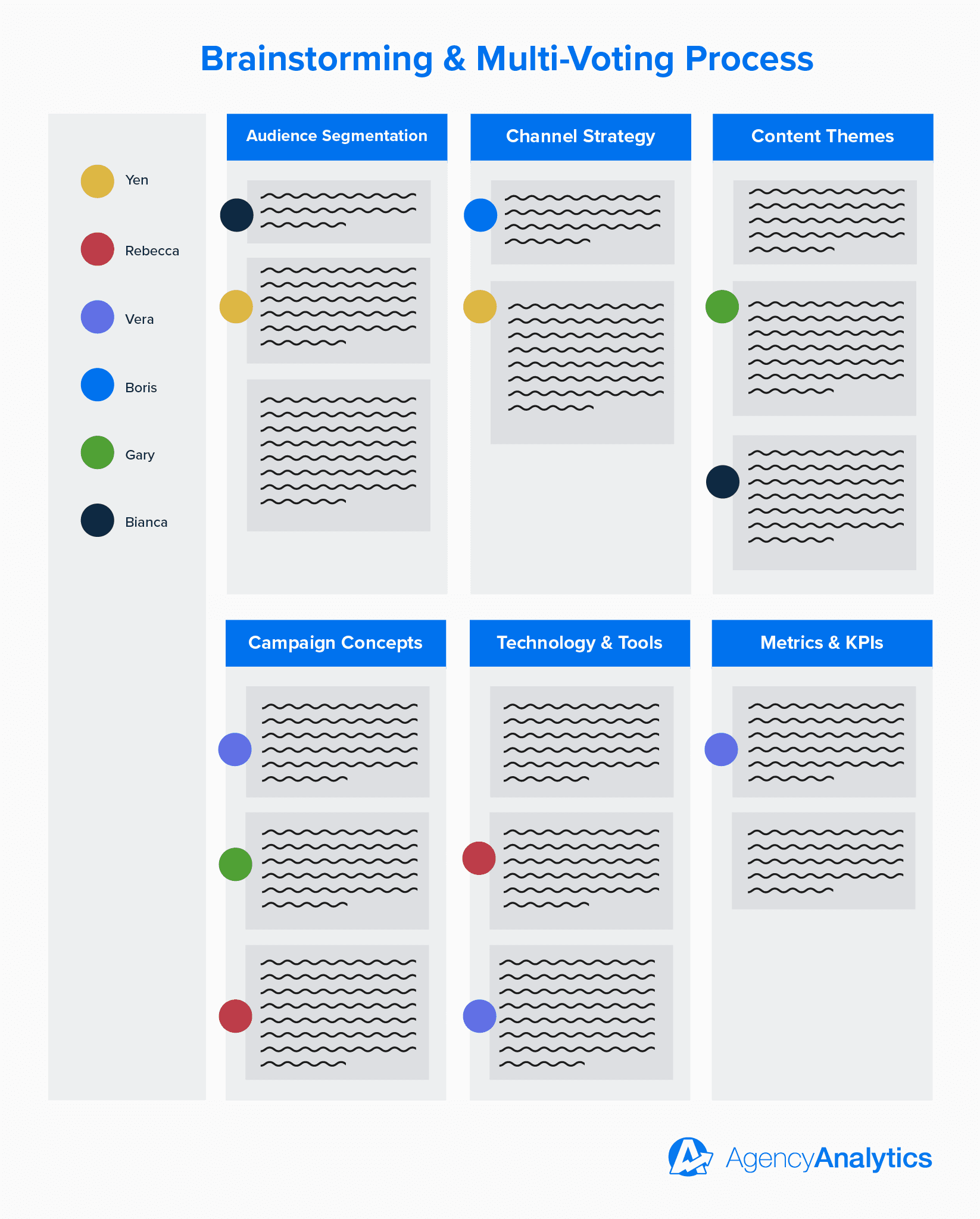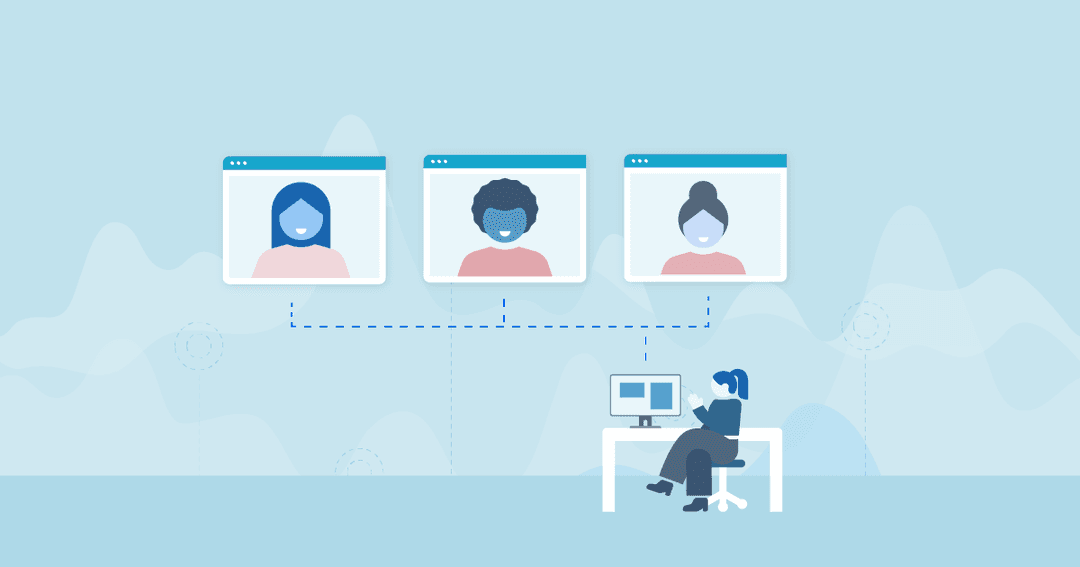Table of Contents
QUICK SUMMARY:
To build consensus without losing momentum, agencies must balance input from relevant internal and external stakeholders while avoiding the dreaded “trial by committee,” where creativity gets watered down by too many opinions. This article offers practical consensus-building techniques to help teams align, reach agreement, and push forward innovative ideas that benefit clients.
Getting new ideas off the ground is tricky for most agencies.
Whether tweaking internal processes or pitching fresh concepts to clients, building consensus among stakeholders is often an uphill battle.
Internally, your team members may push back because they’re used to doing things a certain way. Externally, convincing clients to try something new—a risky campaign, a bold new service, or a design overhaul—also takes effort. Clients are naturally hesitant when something feels untested or unfamiliar.
Change might feel like a hassle, especially when the old systems “work just fine.”
And then there’s the dreaded "trial by committee." You know, the one where everyone has an opinion and consensus-building efforts get bogged down. The creativity that sparked the idea fades as more voices chime in, often turning something exciting into a watered-down version of its original form.
Still, getting everyone on the same page and building consensus is necessary to move ideas forward. A solid consensus decision-making process will ensure team members and clients feel comfortable and confident about what comes next.
If it's all running through one person, it's really not going to be efficient. There's not a whole lot that one person can do. But when you've got nine people working towards the same goal, that's where things can really happen.
Christina Cypher, Director of Marketing, Click Control Marketing
But how do you do that without killing the creative energy? How do you balance involving relevant stakeholders without having too many cooks in the kitchen?
These are the challenges agencies face daily when they try to build consensus around new ideas, and it’s vital to understand how to tackle them head-on.
Why Trial by Committee Is a Creative Energy Killer
We’ve all been there—you're in a meeting, excited to present a new idea, but by the end of it, the idea has been chipped away by a dozen different opinions. This happens when you fall into the "trial by committee" trap.
Consensus-building is great for gathering different perspectives, but too often leads to a watered-down result. That initial spark of creativity gets lost in trying to please everyone.
Still, consensus decision-making is necessary.
You can’t ignore input from your team members or clients. They need to feel heard and have a say in the process.
The trick is figuring out how to build consensus without letting the process kill your creative ideas. It’s about keeping things streamlined and ensuring the right people are in the room—relevant stakeholders who will help move the idea forward.
Agencies that have mastered the consensus-building process understand it’s all about balance. You want buy-in, but you don’t need endless rounds of feedback. The key is knowing when to take feedback on board and when to push forward with the vision.
This is where effective consensus-building techniques, like active listening and creating clear ground rules, come into play.
An effective consensus-building effort will result in better ideas that your whole team and clients can get behind—without losing that creative edge.
Impress clients and save hours with custom, automated reporting.
Join 7,000+ agencies that create reports in minutes instead of hours using AgencyAnalytics. Get started for free. No credit card required.
Why Building Consensus Is Challenging
Building consensus isn’t always easy, and there’s a reason so many agencies struggle with it. When pitching something new–especially a bold idea–everyone involved has their own perspective.
That’s the first big challenge: different perspectives. What one person thinks is groundbreaking might be seen as risky or off-brand by another. This is why consensus-building efforts often hit roadblocks early.
Resistance to change or conflicting opinions across teams and stakeholders is a common issue.
Michelle McNally, EVP Customer Success, BoxCrush
Another issue is that there usually isn’t a clear set of criteria for evaluating ideas. Without a shared framework, stakeholders use their biases or reference points, leading to conflicting opinions.
One team member might be thinking about budget, another might be focused on brand consistency, and another might be concerned about execution. Mismatched priorities make it tough for teams to come to a shared understanding of what makes an idea worth pursuing.
Clients may be just as hesitant. Upselling a new service or pitching a risky campaign is tricky when clients are focused on the bottom line.
I only recommend an upsell when it will truly benefit a client. When proposing something, I can typically point to situations where the idea has been successful. Providing an escape hatch, such as a three-month trial, also gives clients the confidence they need to move forward.
Michelle McNally, EVP Customer Success, BoxCrush
The more innovative the idea, the harder it is for people to agree. Newness brings uncertainty, and with uncertainty comes hesitation. This often turns into “majority rule” decisions, where a strong opinion or two will sway the group, but that doesn’t always mean it’s the right call.
We've added multiple people to our leadership, so it's not just me calling the shots. We have a couple of people to weigh in and make decisions. It’s been good to bounce ideas off of one another and not just have a bottleneck when it comes to decision-making.
Matt Sullivan, Founder & CEO, Torro Media
Consensus building takes effort, and in an agency environment where things move fast, it can feel like a time sink.
Rushed decisions lead to poorly executed ideas, while taking too long to reach a final proposal kills momentum. Finding the right balance between speed and thoughtful decision-making is a constant challenge agencies face.
So, how do you work around these obstacles? A structured consensus-building approach that ensures all voices are heard but doesn’t let the process drag on indefinitely.
7 Tips for Building Consensus With Agency Stakeholders
There are tried-and-true strategies for building consensus that help agencies keep the process moving forward without losing steam. Here are some practical tips to guide you through the consensus-building process.
1. Understand Stakeholders' Reference Points
Before building consensus, understand where each person is coming from. Team members and stakeholders will often have different priorities. It’s important to identify their underlying needs so you tailor your pitch and find common ground early.
When I am ready to introduce a new idea, I gather evidence of where it has been successful. If that is not applicable, I work to find examples where the idea will address a pain point we are experiencing.
Michelle McNally, EVP Customer Success, BoxCrush
2. Present Clear Criteria for Evaluation
Without a clear set of guidelines, discussions become scattered, with no one on the same page. The best way to avoid this is by providing standardized criteria for everyone to use when evaluating a new idea.
When the focus is on shared goals—ROI, creative impact, or operational efficiency—it’s easier for stakeholders to reach a consensus and identify the proposal's strengths and underlying issues.
3. Limit the Number of Decision-Makers
Too many voices will slow things down and cause confusion. One of the best ways to streamline consensus decision-making is to limit the number of decision-makers to only the most relevant stakeholders.
Breaking down those barriers and giving other people the responsibility to make those decisions and come up with different ideas is a culture shift that takes time.
Christina Cypher, Director of Marketing, Click Control Marketing
4. Address Concerns Directly and Proactively
Concerns and objections are inevitable, but ignoring them will create bigger problems down the road.
The key to successful consensus building is active listening and open communication to address these concerns early. Clear the path for a smoother agreement by dealing with potential objections upfront. Often, this involves tackling underlying issues that could derail the process.
I find directly addressing concerns and laying out a timeline for the changes puts people's minds at ease.
Michelle McNally, EVP Customer Success, BoxCrush
5. Leverage Data and Case Studies
People trust data. Real-world evidence makes all the difference if you’re trying to build consensus around a new idea.
Use data, case studies, and success stories to show stakeholders your idea is grounded in proven results. This helps reduce uncertainty and makes it easier to receive buy-in from hesitant team members or clients.
I'll be on a call with one client at 10 o'clock in the morning, and they'll share something with me that’s working for them. At 1 o'clock, I talk with another client and say, “Well, here’s what's working for this other client I have. Is that something that you've tried before? Because we could work with you on that, too.”
Kevin Watts, President, Raincross
6. Build Trust and Credibility
When it comes to consensus-building, trust is everything. Stakeholders are more likely to back an idea if they trust the person presenting it.
Demonstrating expertise and being transparent about risks and rewards builds credibility and creates a strong foundation for the entire decision-making process.
Clients appreciate when we're transparent about whether or not we think an idea will work.
Andrew Logan, Managing Director, Floww Digital
7. Segment Feedback Into Specific Conversations
One of the best ways to avoid unfocused feedback is by breaking discussions down into smaller, more manageable topics.
Instead of asking for general feedback, focus on specific areas like logistics or creative feasibility. A structured method keeps the conversation on track and helps the group reach agreement faster.
It's not always about having the right idea—it's about executing it properly and iterating on it.
Frank Cowell, Founder, Revenue Ranch
Consensus-Building Tools and Techniques for Agency Success
Understanding how to build consensus among stakeholders is a critical skill for any agency. Whether it’s internal collaboration or getting client buy-in, team members and clients need to feel heard and engaged in the process.
The goal isn’t just to get through the meeting—it’s to come away with consensus decisions that everyone supports. Effective teams strive to create an environment of mutual respect, where ideas are openly discussed, and consensus-building group work leads to actionable outcomes.
Adopt Structured Methods To Help Teams Reach a Consensus
Most consensus-building efforts need structured methods to ensure efficient feedback and decision-making.
Tools like multi-voting and the nominal group technique are particularly helpful. They allow team members and stakeholders to vote and provide input without dragging out the process.
By limiting the number of decision-makers involved and focusing on small group discussions, agencies quickly reach a final proposal that works for everyone.

Brainstorming, combined with multi-voting, helps teams reach consensus on key decisions. It allows team members to suggest ideas, discuss differences, and ultimately find an acceptable proposal. These methods help teams avoid endless back-and-forth discussions and keep momentum moving forward.

Adopt Joint Fact-Finding and Problem-Solving
One of the best ways to prevent decision paralysis is through joint fact-finding (JFF): Bringing all the relevant facts to the table ensures that everyone operates with the same information. It’s much easier to reach a consensus when working groups are aligned on the facts.
By focusing on key questions and identifying the strengths of each idea, team members will support each other in the problem-solving process. It also strengthens relationships within the entire group, as people feel more connected when working from a common understanding.

Foster Open Dialogue and Mutual Respect for Better Outcomes
Agencies thrive when open dialogue is encouraged. An effective facilitator helps steer these conversations, ensuring that every team member has the opportunity to contribute while keeping discussions on track.
When group decisions are made in a collaborative environment, it fosters a sense of ownership among the team. Everyone is more invested in the idea because they have a voice. Open collaboration often accelerates the path to reaching an agreement.
Embrace the Power of Consensus-Building
Mastering the art of enlisting buy-in, and leveraging structured consensus-building processes is a game-changer for agencies that want to drive innovation and improve operations.
By focusing on methods like multi-voting and the nominal group technique, agencies ensure that teams strive for consensus without stifling creativity. When all team members actively discuss ideas and differences, they make better decisions and push the agency forward.
Achieving consensus in a team or with clients doesn't always mean you achieve unanimity, but it does mean you get to a place where everyone is aligned and moving in the same direction.

Written by
Francois Marchand brings more than 20 years of experience in marketing, journalism, and content production. His goal is to equip agency leaders with innovative strategies and actionable advice to succeed in digital marketing, SaaS, and ecommerce.
Read more posts by Francois MarchandSee how 7,000+ marketing agencies help clients win
Free 14-day trial. No credit card required.




![What Is the Ideal Marketing Agency Structure? What is the Ideal Agency Structure? [Traditional vs. Pod Hierarchy]](/_next/image?url=https%3A%2F%2Fimages.ctfassets.net%2Fdfcvkz6j859j%2F2kbsPgQU9lNcDbmDyQUAId%2F50627cff0bcd570713198bf15bea9db7%2FIdeal-Marketing-Agency-Structure-Traditional-Pod-Hierarchy.png&w=1920&q=75)

